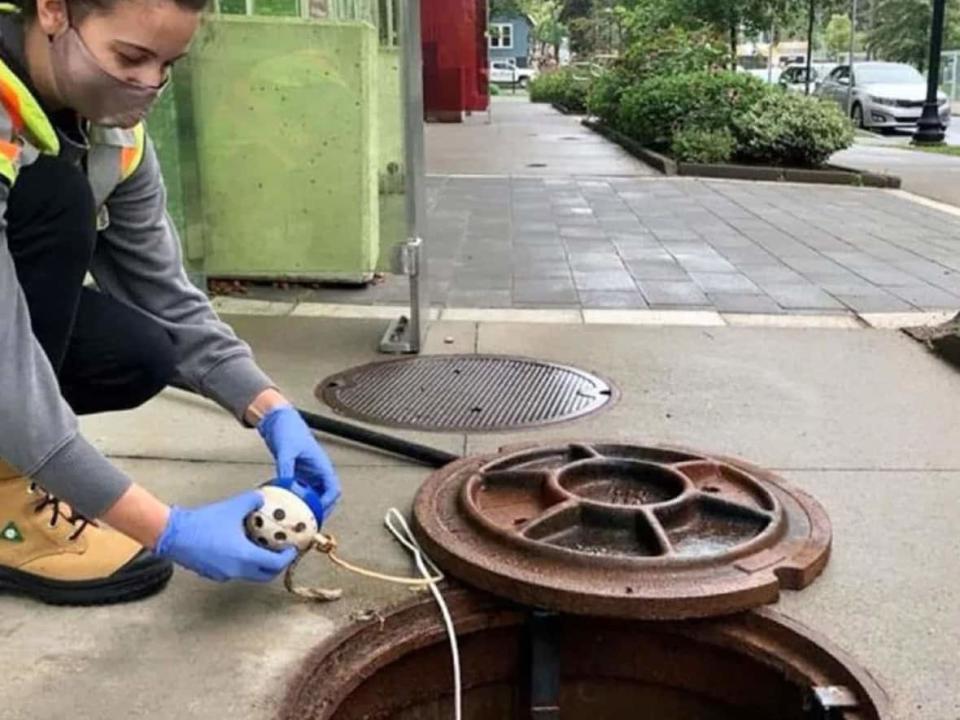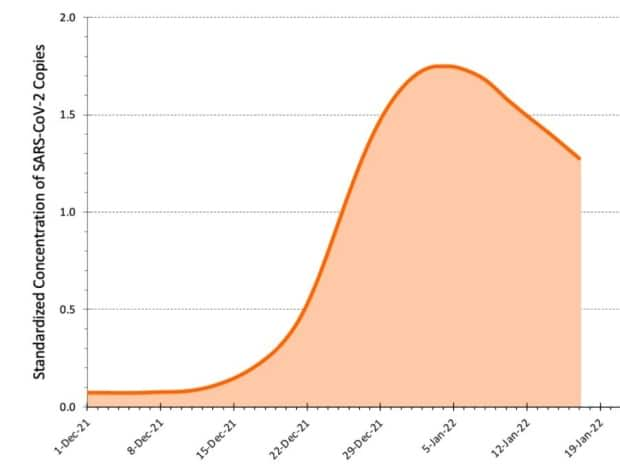Ontario sewage tests indicate slow decline of COVID-19 infection rates

Results from over 80 facilities testing sewage for COVID-19 across Ontario reveal that infection rates in the province have slowly declined following a peak at the beginning of the month.
But scientists, while expressing cautious optimism, say the reopening of schools and loosening of restrictions could send those rates back up.
"Of course it's good news, but we just we shouldn't get ahead of ourselves," Dr. Peter Juni, scientific director of Ontario's COVID-19 Science Advisory Table, who is involved in the wastewater surveillance project, said Friday night.
"It's really decreasing slowly which makes me cautiously optimistic. But we should be careful not to undo the progress we're making right now."
Since the Omicron surge overwhelmed available PCR testing in Ontario and other provinces, eyes have turned to wastewater monitoring for a relative sense of what's happening with coronavirus infections in an area.
Even before an infected person shows COVID symptoms, they shed bits of the SARS-CoV-2 virus, which causes the disease, in their feces. That genetic material in the form of RNA can be detected and monitored in wastewater.
While the wastewater data is not as exact as case counts, it can help understand the trajectory of disease in a community when PCR testing isn't available.
The results from 84 wastewater treatment plants in 33 public health units have been published on Ontario's COVID-19 Science Advisory Table's online dashboard. The data shows a peak of virus concentration in wastewater around Jan. 4, then falling by about a quarter by Jan. 17.
Juni cautioned that the decrease in the infection rate is not a natural wave but caused by "changing our behaviour" due to public health measures that came in after New Years.
"This is not the steep increase and then decrease as we saw it in South Africa, for example. It goes much slower right now because this is us flattening the wave."
"It means we need to be slow with reopening and fast with vaccinating," he said.

Levels still high
Although the provincial data shows an overall slow decline, some researchers have recorded a plateau of infection rates that remain at a high level.
Andrea Kirkwood, an associate professor of biological science at Ontario Tech University who is one of a number of researchers involved in the wastewater COVID-19 surveillance project, said at the beginning of the month, all the sites they were monitoring "spiked really high."
Levels subsequently came down from the peak, but researchers are still detecting a higher virus signal with the Omicron variant compared to previous variants, she said.
"But now it's plateaued," said Kirkwood, whose team monitors 11 wastewater sites, which include Durham Region and Simcoe-Muskoka.
Robert Delatolla, an associate professor of civil engineering at the University of Ottawa, who co-leads the research into wastewater testing for sites that include Ottawa and Hamilton, said while the wastewater signal is plateauing, it's plateauing at "an elevated level."
"We're not the highest signal we've ever seen, [but] there is still a significant proportion of people that are shedding a viral load," he said.
WATCH | Why wastewater data might soon be more important than COVID-19 case counts:
Lawrence Goodridge, a professor of food microbiology at the University of Guelph, who has also been leading the wastewater testing project at the school, agreed the wastewater signal is "flattening across the province."
"However, I urge caution with this because most kids went back to school this week. So I think some of those kids will get infected and therefore the wastewater signal is going to go back up. So we'll have to see in probably a week or two."
Not up, but no guarantee of down
Claire Oswald, a Ryerson University associate professor in geography and environmental studies, who is also leading a wastewater surveillance monitoring network, said their research indicated that in mid-December, the wastewater signal in their sewage samples went up "quite rapidly" compared to previous waves.
But their most recent data, she said, now indicate a plateau.
Her team has been monitoring the Humber Wastewater Treatment Plant, which serves over 700,000 people in the west side of Toronto.
"Personally, it's too early for me to feel confident that it's going to go back down. There's a lot of variability in wastewater surveillance data," she said.
"The more data we have, the more confident we're going to feel about whether or not we're starting to head back down. But I definitely can say it's not heading back up anymore."
WATCH | How does wastewater help with surveillance of COVID-19:
Other regions have reported similar results. In Waterloo, testing shows the Omicron variant of COVID-19 has pushed infection levels to more than 10 times higher than ever before but there are early indications that infections may be starting to level off there too.
On Thursday, the Ontario government announced it would begin easing public health restrictions at the end of the month, and plan to lift most remaining measures by mid-March.
That decision was based on data that show new admissions to hospital and ICUs have begun to slow. As well, Public Health Ontario logged a 15.9 per cent positivity rate of COVID-19 on 42,907 PCR test samples, the lowest rate recorded in Ontario since Dec. 21.
Dr. Kieran Moore, Ontario's chief medical officer of health, said that positivity rates appear to be flattening between 20 and 25 per cent, after climbing into the high 30s earlier this month.
WATCH | A look inside Ottawa's wastewater facility where COVID-19 samples are collected:
PCR testing restricted
There are, of course, limits to what the PCR tests can show since criteria was significantly restricted in early January, including those in hospitals and high-risk individuals. Results may significantly underplay the actual number of people in the province who are infected.
That's why some experts have said wastewater surveillance may be a much more accurate indicator of COVID-19 rates.
"Now that the clinical data is less reliable, people are more interested in [wastewater surveillance],"Oswald said. "And I think there's potential for it to give us a clearer picture of what's going on."
But Oswald said the PCR tests and other provincial data just released "do look similar to some of the wastewater surveillance data that I've seen," giving a stronger suggestion the trends may be real.
WATCH | Wastewater samples point to where COVID-19 cases are:
'Fine tune the technique'
The wastewater surveillance initiative is sampling at over 170 locations covering more than 75 per cent of Ontario's population across all 34 public health units, said Gary Wheeler, a spokesperson for the Ontario Ministry of the Environment, Conservation and Parks, in an email to CBC News.
Currently, samples are collected from 117 community sites, which include wastewater treatment plants, pumping stations and lagoons. Samples are also taken from 57 upstream high-risk congregate locations: correctional facilities, hospitals, long-term care homes, retirement homes, shelters, university campuses and neighbourhood sewersheds, Wheeler wrote.
"We're able to capture a good chunk of the population of the province. And we had the last year to really fine tune the technique," Kirkwood said.
"We were able to really improve the technique to the point that we're very confident in what the trends are showing us."

